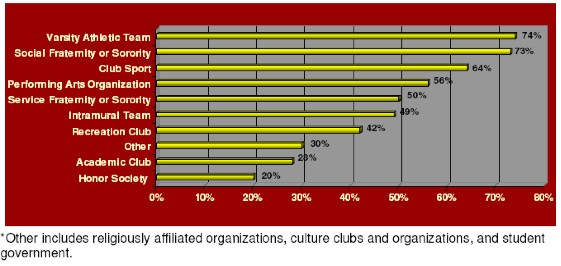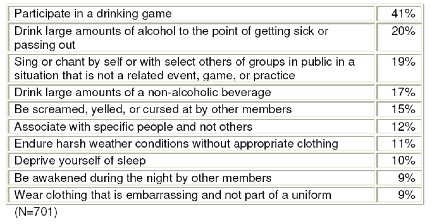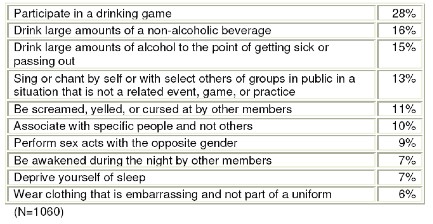Research
Hazing among college recreational sports participants

Did you know that a portion of college recreational sports participants are involved in hazing? NIRSA, aware of the commonality of hazing and its effects on college recreational sports participants, has collaborated on a research project taking place at the University of Maine. As part of the collaboration, Dr. Danell Haines, Director, National Research Institute for College Recreational Sports & Wellness, serves on the project advisory board. Other collaborating and sponsoring organizations include the NCAA, NASPA, and the American College Personnel Association, to name a few. Drs. Elizabeth Allan, Assistant Professor of Higher Educational Leadership and Mary Madden, Assistant Professor in the College of Education and Human Development, serve as the investigators on the three-phase project. Phase I involved developing and pilot testing the hazing study survey. Phase II entailed refining the survey, recruiting institutions nationwide, and administering the survey via the internet as well as conducting individual interviews with students, faculty, and staff. Finally, in Phase III, the project data will drive the development of interventions to reduce the prevalence of hazing.
Upon the completion of Phase II, data was gathered from 11,482 questionnaire respondents from 53 colleges and universities. Specific institutions were asked to participate in order to align with the Carnegie classification system and provide a sample generalizable across all areas of the country. Each selected school randomly sampled 25% of their full-time undergraduate student population. Upon receipt of questionnaires, researchers conducted over 300 interviews with students, faculty, and staff from representative universities. Results were presented in aggregate as well as separated by participant group.
The researchers found that hazing was reported across many types of teams and student organizations. Hazing was defined as “a dangerous behavior, unrelated to qualifications for a group, that one was compelled to engage in to be part of a group.” Varsity athletes, members of social and service fraternities, band and performing arts members, as well as those who participate in sport clubs and intramurals all engaged in drinking games, were forced to sing or chant, and got sick or passed out from being forced to drink alcohol.
The survey revealed that students affiliated with a range of student groups reported experiencing hazing behaviors. Students were provided with a list of behaviors and asked if they had experienced any of the behaviors in the process of joining or maintaining membership in a student activity. The following is a partial list of the behaviors:
- Attend a skit night or roast where other members are humiliated
- Sing or chant by yourself or with a few select team members in a public situation that is not related to the event, game, or practice
- Wear clothing that is embarrassing and not part of the uniform.
- Be yelled, screamed, or cursed at by other team/organization members
- Get a tattoo or pierce a body part
- Act as a personal servant to other members
- Associate with specific people and not others
- Deprive yourself of sleep
- Be awakened at night by other members
- Make prank phone calls or harass others
- Be tied up, taped, or confined to small spaces
- Be transported to and dropped off in an unfamiliar location
- Endure harsh weather without the proper clothing
- Drink large amounts of a non-alcoholic beverage such as water
- Participate in a drinking game
- Drink large amounts of alcohol to the point of passing out or getting sick
- Watch live sex acts
- Perform sex acts with the same gender
- Perform sex acts with the opposite gender
- Keep a tally of men or women with whom you have had sex
Results indicate that hazing is common among a large variety of student organizations, teams, and clubs. The results presented below demonstrate the percentage of students who had experienced at least one hazing behavior.
Percent of Students in Each Activity that Experienced at Least One Hazing Behavior

Overall results also indicate several other trends:
- 55% of students involved in clubs, teams, and organizations have experienced hazing
- Alcohol consumption, humiliation, sleep-deprivation, isolation, and sex acts are hazing practices seen across all student groups
- More students perceive positive rather than negative outcomes of hazing
- 95% of hazing cases were not reported to officials
- 25% of coaches/advisors/leaders were aware of hazing behavior
- 90% of students who have experienced hazing behavior in college do not consider themselves to be hazed
Among all respondents, the most common behaviors reported by students were as follows:
- 26% - Participate in a drinking game
- 17% - Sing or chant by self or with other selected group members
- 12% - Associate with certain people and not others
- 11% - Deprive self of sleep
- 10% - Drink large amounts of a non-alcoholic beverage
- 10% - Yelled, screamed, or cursed at by other group members
- 9% - Be awakened during night by other group members
- 6% - Perform sex acts
Hazing Results Specific to College Recreational Sports
The study examined hazing behaviors according to membership groups. The following table illustrates the behaviors, and the percent of respondents who say they participated in the hazing behaviors in order to join or maintain membership in Sport Clubs.
Hazing Behaviors Reported by Club Sport Participants

As observed, sport clubs participants are susceptible to many forms of hazing. For professionals in the field this information is essential. It may allow for comparison of prevalence rates among college activities and an understanding of the scope of the hazing problem within sport clubs. It may also encourage awareness of hazing, behaviors common in hazing situations, and situations in which hazing is most common. Most important, the results may lead to a better understanding of why hazing occurs as well as the development of programs designed to prevent hazing.
Club sports were not the only recreational sports group who demonstrated hazing practices, however. The table below illustrates the most common forms of hazing within intramural sports. It is notable that intramural participants reported less hazing activity (49%) than sport club participants (64%). The authors did not hypothesize why the prevalence of hazing is more common among sport club participants than among intramural participants. One explanation of the differences in the amount of travel associated with different activities may impact this discrepancy. Also, the amount of time spent with teammates may be greater among sport club participants, which could lead to more opportunity for hazing to occur. Further investigation will be necessary to provide suggestions about the higher prevalence of hazing among sport club participants.
Hazing Behaviors Reported by Intramural Participants

As observed with sport clubs, drinking games are the most commonly practiced hazing behavior among intramural participants. This finding may suggest that interventions aimed at hazing within recreational sports would be remiss if they did not focus on decreasing the prevalence of drinking games.
The data shows that sport club and intramural participants are susceptible to many forms of hazing. For college recreational sports professionals, this information is important because it shows the scope of the hazing problem among our program participants. It is expected that the results will lead to a better understanding of why hazing occurs as well as the development of programs designed to prevent hazing. Phase III of this study will further analyze the study results and provide suggestions for interventions that will reduce hazing.
For additional information about the hazing study see http://www.hazingstudy.com.
Article summary provided by The National Research Institute for College Recreational Sports and Wellness. Dr. Danell J. Haines, Director; Tyler L. Fortman, GAA.
|

